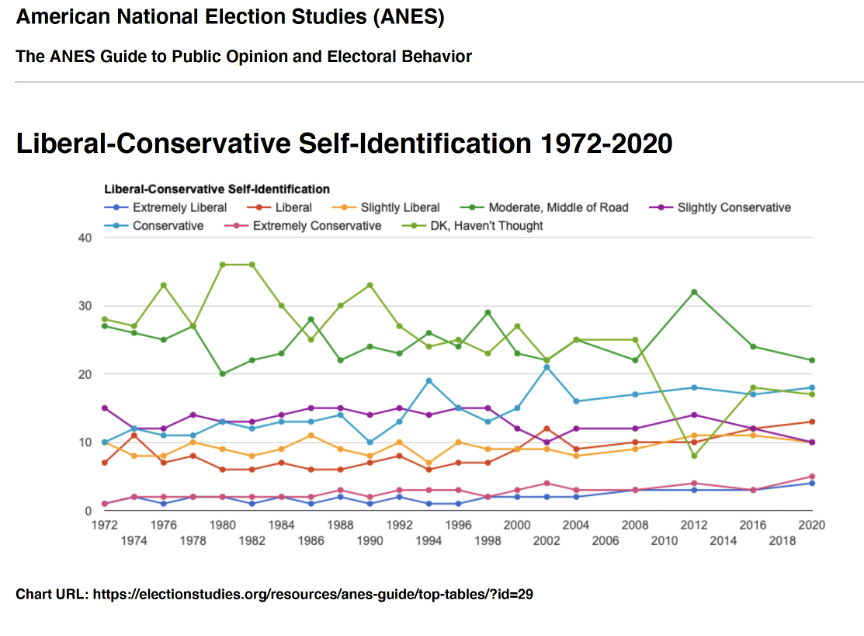Detecting the Middle Majority
More Americans reside in the middle of the political spectrum than we're often led to believe. That reality presents voters with an opportunity to reimagine political engagement.
Oregon’s legislature was in a near meltdown over redistricting. School boards and constituents are tensely facing off over education standards. Congress continues is 11-year run of almost completely failing to govern.
Things look bad in the political world.
But two recent articles point out that the body politic is more in agreement than the news would suggest. And they highlight that the acrimony and yelling we see comes from a relatively small part of our communities.
Tony Woodlief wrote on Governing.com that, as the subtitle summarized, “Despite what the pundit/political class says, most Americans agree on a lot more than they disagree on. Partisanship is real, but it doesn’t define us.” Looking at analyses and studies from the last several years (the oldest is form 2014; the newest from September 2021) Woodlief points out some of the realities of our political life.
Those who identify as extremely liberal or extremely conservative remain a tiny portion of the public. As of 2020, it was about 4% on the very liberal side and 5% on the very conservative, percentages that have been remarkably stable for the past fifty years. That leaves about three-quarters of us somewhere from center-right to center-left. For many years, the largest single liberal-conservative group was those who didn’t know where they stood or hadn’t thought about it. That has changed in the past decade with the largest group now being moderates, followed by conservatives, don’t knows, and liberals. Clearly, we are a centrist citizenry.
The percentage of national voters who self-identify as independent has been growing since Watergate. But in the past few years it has been the biggest single group—September 2021 numbers from Gallup show 41% independents, 29% Republicans, 29% Democrats. Oregon has followed this broad trend (although here the Democrats are much more numerous than Republicans). We are on track for Oregon unaffiliated voters to surpass Democrats sometime in the next couple of years.
Woodlief found strong support among Americans “to protect the rights of people with unpopular views.” There’s more support for allowing expression than canceling viewpoints. There’s also more support for compromise than partisan-pleasing recalcitrance. When asked about what the president and Congress should be doing, 65%–85% of Americans think that the two branches of government should be cooperating with each other even when party control is divided.
What’s true nationally is also true at home. A September 2021 Oregon Values and Beliefs Center poll found that 60% of Oregonians agreed that there are things that “cut across political divides and represent common ground” regardless of where people live and what party they subscribe to (or don’t). Leading the list: environmental quality, natural beauty, and economic conditions.
There are still many issues that divide us, but they are part of a wider range of issues about which we more or less agree. It is to the advantage of those with political power to focus on the divides—this attention to the edge issue fires up political bases, raises money, and gets headlines. But it also contributes to the feeling that politics is just a battle.
Remember, one of the things new legislators discover in Oregon is that about 80%–85% of bills pass with overwhelming bipartisan support. We agree more than we disagree. What gets the headlines is the 15%–20% of bills that become partisan brawls.
Clay Jenkins, a humanities scholar, came up with coping mechanisms for our seemingly troubled times. Three of them are ways to observe and comment (‘escapism,’ ‘the enlightenment of one,’ ‘virtual communities’), but they are not ways to engage with the issues around us. Option four, ‘into the arena’ is what is required. But the arena, as Jenkins writes, “is now so filled with hate, invective, sneering, blind partisanship, tribal pride, the demonization of the other…that who wants to jump in?”
By focusing on what we agree upon, then building from there and getting into the arena, our body politic can regain some of its effectiveness (I am looking at all of you in D.C.…). People can begin to trust that government is where solutions lie, not where partisan power is fought over and wasted by shortsighted political operatives.
Longtime observer of Oregon and west coast politics. Political analyst for various media outlets, professor at Pacific University.





